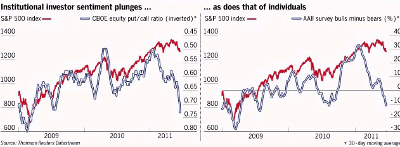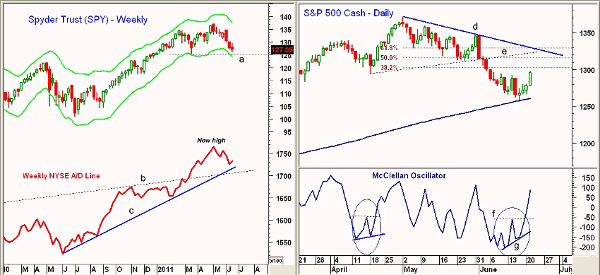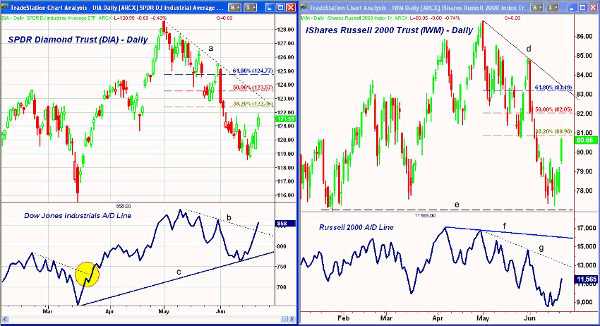Many don’t trust the market’s latest rally, but technical indicators suggest that even when this rally stalls, the market may be well supported for a new run to the prior highs. Here are key measures to watch.
There were some signs after last Friday’s close that the market was close to a short-term low (see “Is the Worst of the Selling Over?”). Several of the major averages formed weekly dojis last week, which is a technical formation that indicates indecision. That makes this week’s close even more important.
The strong action early this week is being treated with distrust, which is not surprising considering bearish sentiment has reached rather high levels. An interesting article in the weekend Financial Times, “Investors Shaken by the Fear Factor” (registration required), discussed several different measures that reflect the high degree of negative sentiment.
The above chart shows that that the put/call ratio reached its highest reading since November 2008. The high level of put purchases is frequently used as a contrary indicator.
I have been noting the negative sentiment of the American Association of Individual Investors (AAII) members for a few weeks, and the second chart shows that the percentage of bulls minus bears peaked in early 2011. It is now down to levels last seen during the summer of 2010. Also, a recent survey by Merrill Lynch reflects very high cash levels, suggesting a high level of bearishness.
So with the public either distrustful or afraid of the stock market, and market professionals generally looking for a rally failure, what can we expect now?
Chart Analysis: The weekly chart of the Spyder Trust (SPY), updated through last Friday, shows that SPY came within 0.6% of the weekly Starc- band.
- SPY has held above the March lows at $125.28 (line a)
- The weekly Advance/Decline (A/D) line turned up last week and was able to hold above the longer-term uptrend, line c. There is further support for the A/D line at line b
- The new high by the NYSE weekly A/D line in early May is a positive sign for the intermediate-term trend
The daily chart of the S&P 500 shows that the 200-day moving average (MA) was tested last Thursday before the S&P closed the day higher.
- The 38.2% retracement resistance is at 1301 with the 50% retracement resistance at 1314
- The former support (line e) the downtrend from the highs, line d, are in the 1323-1328 area with the 61.8% retracement resistance at 1329
- The McClellan Oscillator, a short-term A/D indicator, formed a positive divergence on Thursday, line g, which was confirmed by the move above resistance at line f
- A similar formation in April signaled a week-long rally
- The Oscillator closed at +87 and is not far below the previous peaks at +113 and +129. On a pullback, I would look for it to drop back to the -50 area
NEXT: The Most Positive Recent Market Development
|pagebreak|The most positive development is in large-cap stocks, as represented by the SPDR Diamond Trust (DIA) which tracks the Dow Industrials. Last week, DIA formed a doji with a low of $118.55 and volume hit a four-week high with the higher close.
- The daily chart shows that DIA is already close to the 38.2% resistance at $122.36 with the downtrend (line a) and the 50% resistance at $123.57
- The more important 61.8% resistance is at $124.77 and a close above this level would be a strong sign that the market’s decline is over
- More important is the action of the Dow’s A/D line, as it has broken its downtrend, line b. This has not yet occurred for the S&P 500 or other major averages. In March (highlighted in yellow), a similar trend line break was very positive
- The longer-term uptrend (line c) in the A/D line did hold on the decline
After a 10% drop from the early-May highs, the iShares Russell 2000 Index Fund (IWM) has rebounded sharply and is already close to the 38.2% retracement resistance at $80.90.
- The 50% resistance for IWM is at $82.05, with the 61.8% resistance and the downtrend (line d) in the $83.49 area
- IWM was the weakest market index at the May highs, as its A/D line did not confirm the highs, instead forming a negative divergence, line f
- The A/D line has turned up sharply but is still below even its short-term downtrend, line g
- IWM has initial support in the $78-$79 area, as the March lows (line e) in the $77 area held on the decline
What It Means: The prevailing market view seems to favor a rally to the 1300-1315 area in the cash S&P ($130.50-$131.80 for SPY) and to the 12,260 area on the Dow Industrials ($123.60 for DIA).
I would expect that many will be buying puts or shorting the futures on this rally. John Person, an expert in the Commitment of Traders (COT) data, reports that the small speculators are already heavily short the futures, and historically, they are wrong at key turning points.
I would also expect a pullback from these resistance levels, but instead of a decline back to last week’s lows (or lower), my view is more positive.
I would look for a one- to two-day correction once the rally stalls in the next week or so, but then I expect the market to be well supported and rally above the prior highs. This could start a short squeeze.
Watching the A/D ratios will be important over the next week. A stronger rally after a pullback could generate new buy signals from the NYSE and S&P A/D lines. This would confirm the positive action in the Dow Jones A/D line.
The NYSE data on the number of stocks making new lows and new highs did not show a strong increase in the number of new lows on the recent decline. So far, the new lows have not exceeded 100, which is well below the January 2011 peak of 149. This is a positive sign.
How to Profit: For those who are fully invested in stocks and have ridden out the market’s decline, raising some cash as the market moves higher would be a prudent step. Though my analysis does not suggest a major top has been completed, raising cash will give you the ability to buy stocks with the best relative performance, like these three railroads, for example.
Previously, I recommended the primary ETFs tracking a few of my favorite market sectors. Here is an update on those positions:
Select Sector SPDR - Health Care (XLV): My initial buy zone at $34.40 was missed, as the low was $34.63. I would now go 50% long at $35.14 and 50% long at $34.96 with a stop at $33.92 (risk of approx. 3.2%).
Select Sector SPDR - Consumer Staples (XLP): Buyers should be 50% long at $31.12, and would now add a 50% long position at $30.96 or better with a stop at $30.54.
Select Sector SPDR - Utilities (XLU): Buyers should be 50% long at $33.16 and 50% long at $32.86 with a stop at $31.88.





















